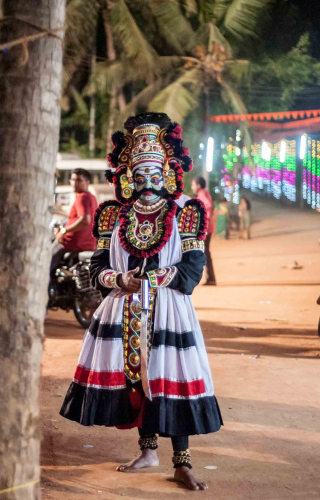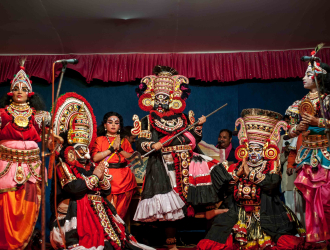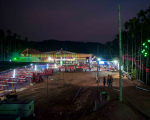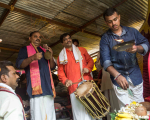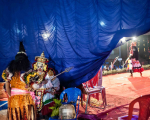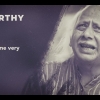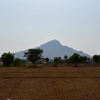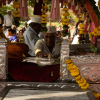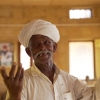‘We don’t remain ourselves, we completely drown in the character we are playing,’ Sai Suma, a Yakshagana artist, who often plays male roles, tells me. She goes on, ‘The more we perform, the more Yakshagana changes our personalities—our voice becomes louder, our walk more masculine—people say why are you walking like that!’
I travelled to Coastal Karnataka, the home of Yakshagana, to learn about and photograph Mahila Yakshagana. I was curious to see the form that this young practice is taking, as women are participating as equals in this performing art space that solely belonged to men for hundreds of years.
The first all-women’s troupe was put together in 1989 by Poornima Rai, one of the pioneers of Mahila Yakshagana. ‘At that time there was not much opportunity for growth in Yakshagana. The situation is a lot better now—parents are much more supportive,’ says Poornima, who currently teaches 200 students at her home in Surathkal, in the suburbs of Mangalore. The students are from all age groups, ranging from five to 65. By the early 2000s, more women, some of whom were dancers from other traditions like Bharatanatyam, were involving themselves with Yakshagana.
One such dancer was Sumangala Ratnakar, who joined forces with Poornima Rai to encourage Mahila Yakshagana. As she was preparing for a programme in 2013, a new thought came to her mind: ‘Why don’t we do an all-women prasanga?’ Before that we didn’t have the opportunity to do a seven-hour full-fledged performance. To be honest, in 2013, before this programme, the idea of Mahila Yakshagana had not gained much prominence. At the beginning there was fear about how it will turn out. But touch wood, by god’s grace, the program was such a huge hit that there was no looking back for Mahila Yakshagana.’
‘Many years ago, Yakshagana used to be performed in paddy fields or in temple premises. Once the day’s work was complete, people carrying mats would come from far away and spend the night watching the performance. It was a kind of an unwinding after a long day’s work—for the performers as well as the audience,’ Vasundhara Shetty, a Yakshagana artist, says.
Yakshagana is said to have originated between the 11th and 16th centuries, remaining a predominantly male practice until recently. Many new influences from theatre, temple arts, folk and rural arts, cinema, and the artists’ own imaginations, have all been interwoven over a period of several hundred years. The content of the dance dramas is typically drawn from the kavyas— the epic poems Mahabharata and Ramayana, and the Puranas. Folk tales have been a more recent addition. Bringing together costume design, make-up, theatre, dance and music, Yakshagana is one of the richest art forms in India.
The performance is controlled by a storyteller (the bhagavatha) who narrates the story by singing (which includes prepared character dialogues) as the actors dance to the music, portraying elements of the story as it is being narrated. The entire progression of the performance is controlled by music. However, the role of music in Yakshagana is only to complement the dance and acting. Initially, the medium of narration was in Sanskrit, but nowadays Tulu and Kannada, the local languages of coastal Karnataka, are more popular. The dance drama has evolved to become a year-round show performed by professional troupes, which means the audience now require tickets to watch them. As it stands today, Yakshagana is progressively becoming more inclusive—not merely with regard to its content, form or audience but also in terms of who the performers are.
Vasundhara explains, ‘The inclusion of women and children has led to renewed interest in Yakshagana. They say that Yakshagana is seeing a growth curve now because of the number of women and young children who practice and learn the art with heartening enthusiasm. If we continue to develop the form while keeping in mind its roots, we can say that the future holds promise.’
As I learnt about Yakshagana, I was of course struck by the drama of the painted faces, the frills and colours on their costumes and the towering headgear. But beyond the performances onstage, I was particularly fascinated by the world of the Yakshagana backstage. Unlike most other green rooms that are inaccessible to non-performers, the Yakshagana green room is a space that welcomes friends and family, children and curious onlookers like me intent on documenting them.
Owing to the improvisational nature of Yakshagana, there is much conversation and camaraderie between artists in the green room. There is a sense of comfort and ease that nestles in the atmosphere, as if it is simply an extension of their homes. One catches them discussing the upcoming performance: ‘How do you want to play your character?’ or ‘What are you feeling like today?’—they ask each other. They then guide the narrative of the performance based on this interaction. The idea of a set script is absent and rehearsals are seldom held.
I was most mesmerised by the transformation of the women I met into mythical, larger-than-life characters. Many women have embraced Yakshagana for the sense of physical freedom that it has allowed them to experience: the exaggerated, big, broad and open movements, which are otherwise atypical attributes of a ‘feminine’ body, are found to be liberating. The women and young girls I met in the green rooms shared their stories with me with bare honesty and allowed me a peek into their world of Yakshagana like I was never an outsider. The following series of photographs hopes to show this world of Mahila Yakshagana—the performances, the explosive mela that their green rooms are, and the quieter, more personal, magical narrative of the artist transforming from the person they are into the heroic characters they perform.
